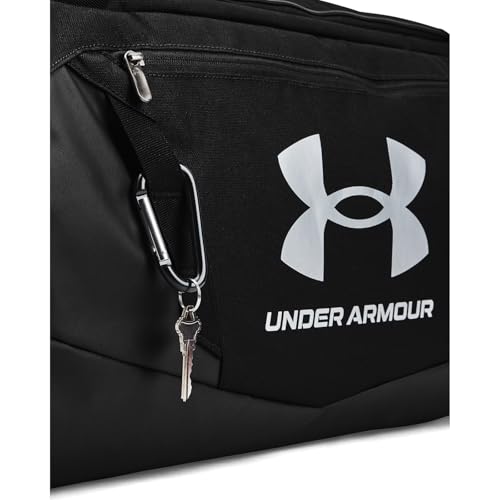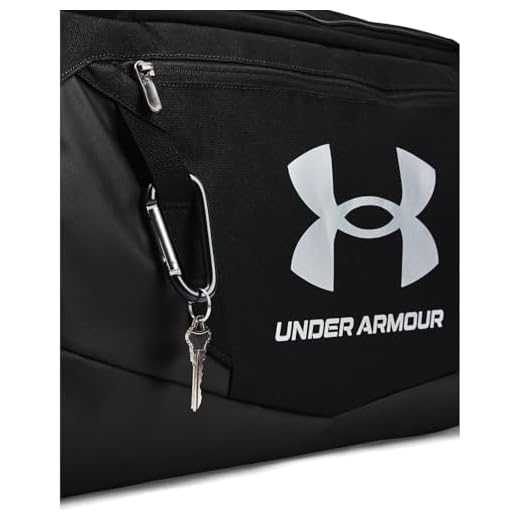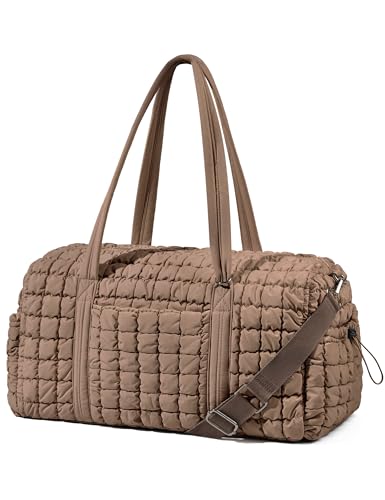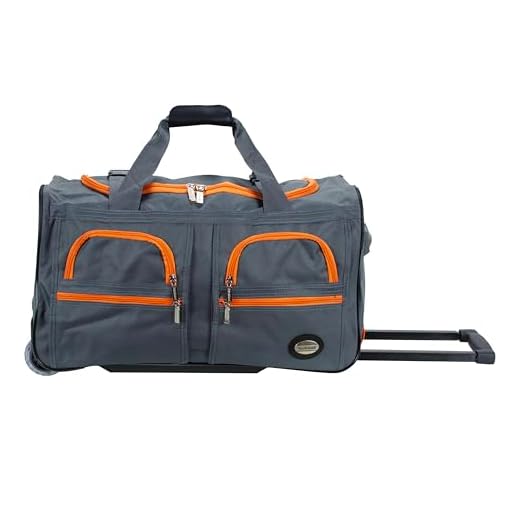

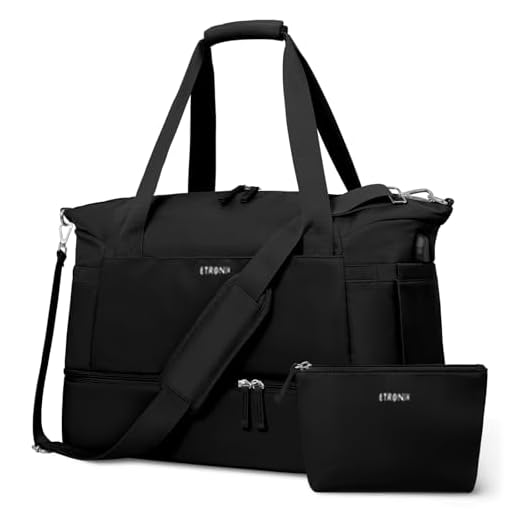

Opting for a soft duffel can be a practical choice for hand luggage, provided it adheres to airline size regulations. Most major carriers allow for a maximum dimension of 22 x 14 x 9 inches, making many duffels a fitting option if correctly sized.
Considering features is paramount. Look for straps that facilitate easy handling and a design that maximizes space without becoming cumbersome. Organizational pockets can enhance convenience, enabling you to separate essentials like electronics, travel documents, and personal items swiftly.
Weight is another aspect to keep in mind. Lightweight materials can help avoid unnecessary fees due to weight limits. Furthermore, a duffel with a compressible design can adapt to fit snugly in overhead bins or under the seat, ensuring a smooth boarding process.
Lastly, be aware of the specific policies of your chosen airline, as requirements may differ significantly. Always measure and familiarize yourself with any limits that may influence your travel experience.
Suitability of a Duffel as Cabin Luggage
A soft-sided travel duffel meets most airlines’ cabin luggage dimensions, making it an excellent option for in-flight storage. Ensure the chosen model adheres to the specific size requirements set by the airline.
Factors to consider include:
- Dimensions: Commonly accepted maximum dimensions are 22 x 14 x 9 inches (56 x 36 x 23 cm). Verify your airline’s specific guidelines.
- Weight: Check weight restrictions for cabin luggage. Lightweight options help avoid excess fees.
- Pockets and Compartments: Look for multiples pockets, which allow easy access to essentials like travel documents and electronics.
- Material: Opt for water-resistant materials to protect belongings from spills and weather conditions during transit.
- Straps and Handles: Comfortable carrying options enhance convenience when navigating airports.
Maximizing Space and Organization
Efficient packing techniques can optimize space inside a travel duffel:
- Rolling Clothes: Roll items instead of folding to save space and reduce wrinkles.
- Utilizing Packing Cubes: Organize items with packing cubes, helping maintain order within the bag.
- Limit Footwear: Select versatile shoes that can be worn on multiple occasions.
- Layering Items: Place heavier items at the bottom and lighter ones on top for balanced weight distribution.
With strategic selection and packing methods, a travel duffel can effectively replace traditional cabin baggage, catering to various travel needs.
Understanding Airline Size Restrictions for Carry On Luggage
Always check each airline’s specific size guidelines before traveling. Most airlines adhere to a maximum dimension of 22 x 14 x 9 inches for hand luggage, including wheels and handles. Some carriers may be stricter, while others might allow slightly larger items. Consider measuring your personal item against these standards to avoid additional fees or complications at boarding.
Weight Limits and Additional Restrictions
Weight restrictions often accompany size limits. Standard allowances can vary from 15 to 25 pounds, depending on the airline. Use a luggage scale to ensure compliance. Packing strategically, by distributing weight evenly, can help maintain balance and reduce strain.
Prohibited Items
Be aware of items not permitted in cabin baggage, including sharp objects, liquids over 3.4 ounces, and substances classified as hazardous. Always refer to the TSA guidelines if flying within or to/from the United States. For international travel, consult the relevant authority in your departure country.
For families, when selecting an appropriate travel companion for your little ones, consider checking out the best toddler backpack for travel, which meets cabin size criteria while providing ample space for essentials.
Benefits of Choosing a Duffel for Travel
Opting for a versatile soft-sided travel option offers numerous advantages for those on the move. These travel essentials provide ample space without cumbersome frames, allowing for easy packing of multiple items. Their flexible nature accommodates odd-shaped items, making them ideal for longer trips.
Organization and Accessibility
The design typically features multiple compartments and pockets, aiding in the organization of personal belongings. Quick access to essentials, whether in an airport or during a layover, simplifies the traveling experience. The ability to open the main compartment wide makes packing and unpacking a breeze.
Lightweight and Comfort
This type of luggage often weighs less than traditional hard-case suitcases, enabling you to maximize packing without exceeding weight limits. Many models come equipped with comfortable shoulder straps or handles, making transport easier. This practicality is further enhanced by their ability to fit into various spaces, such as under airplane seats or in overhead bins.
On a different note, if you’re curious about potential dietary effects, you might want to learn about can red wine cause acid reflux.
Packing Tips for Maximizing Space in Your Duffel
Roll clothing items instead of folding them to save space and reduce wrinkles. Use vacuum-sealed bags for bulky items like jackets or sweaters to minimize their size.
Utilize any available pockets efficiently. Store small essentials, such as chargers and toiletries, in zippered compartments to keep items organized and easy to access.
Fill empty spaces with smaller items like socks or intimate wear. This technique not only optimizes space but also helps maintain the bag’s shape.
Consider packing cubes for structured organization. These can greatly aid in separating different categories of belongings, making it easier to find items when needed.
For travel essentials, choose lightweight alternatives, and avoid packing heavy items that aren’t necessary. This approach reduces overall weight and maximizes room for more vital belongings.
Lastly, remember to check airline guidelines to ensure your packed items comply with regulations. For an added layer of convenience, you might want to check out the best sabio umbrella, which can be easily stowed in your travel gear without taking up much space.
Common Mistakes to Avoid When Utilizing a Duffel for Air Travel
Avoid overpacking. Excess weight can lead to unexpected fees or having to check the item. Prioritize necessities to optimize space.
- Disregarding airline dimensional limits. Always verify the size requirements set by the airline, as dimensions vary among carriers.
- Neglecting to organize essentials. Utilize packing cubes or pouches to streamline access to items like toiletries or electronics.
- Ignoring weight distribution. Place heavier objects close to the bottom to maintain balance and prevent strain during transit.
- Failing to select a versatile style. Opt for an option that includes both handles and a shoulder strap for increased convenience.
- Bringing prohibited items like sharp objects or liquid containers over specified limits. Familiarize yourself with TSA regulations to avoid issues at security checkpoints.
Be cautious about choosing the wrong materials. Waterproof or durable fabrics can protect belongings against spills or adverse weather.
Finally, packing without a checklist can lead to forgetting crucial items. Make a list prior to packing to ensure nothing gets left behind.
Real-Life Experiences: Travelers’ Insights on Using Duffel Bags
Many travelers have praised the practicality of a soft-sided travel sack for their trips. One traveler mentioned how the lightweight and flexible design allowed them to squeeze their luggage into overhead compartments without hassle during a recent flight. This feature proves beneficial, especially when traveling on smaller regional airlines.
Another individual shared their experience of packing efficiently for a week-long trip. By rolling clothes tightly and utilizing packing cubes, they managed to fit an astonishing amount of items. They highlighted that having multiple compartments helped organize essentials, such as toiletries and electronics, for easy access during security checks.
A frequent flyer discussed the importance of choosing a design with sturdy handles and a removable shoulder strap. They noted that, during a long layover, the ability to carry their luggage comfortably made moving through the airport much smoother. A well-constructed option offers adaptability in different travel situations.
Many travelers have reported facing challenges with airport regulations. One traveler recalled an incident where their chosen model exceeded specified dimensions, leading to extra fees. Consulting the airline’s guidelines in advance proved invaluable in preventing last-minute surprises.
Some users pointed out drawbacks as well. They mentioned that zipper issues could arise after heavy use, stressing the need for high-quality materials. Regular inspections before departure became part of their packing routine to mitigate these risks.
| Traveler | Insight |
|---|---|
| Hannah | Praise for flexibility in storage space |
| Brian | Efficient space management with packing cubes |
| Clara | Importance of sturdy handles and straps |
| Mark | Avoiding fees by checking size limits |
| Susan | Need for high-quality materials to prevent wear |
By sharing their experiences, travelers have helped to outline both the advantages and potential issues of using a travel sack for air travel. Learning from their insights can aid in making informed decisions for future adventures.

